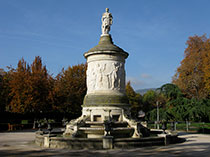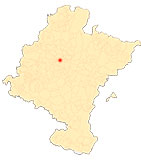The memorial in Pamplona
Monument to Julián Gayarre
-
Author: Fructuoso Orduna. Architect: Víctor Eusa.
-
Materials and technique: white marble and stone.
-
Measurements: Set: 1,200 cm; Lantern diameter: 1,000 cm; Image: 250 cm.
-
Location: Taconera Gardens. Central promenade.
-
Date of installation: 5 July 1950 (inauguration).
In 1947, the Roncal sculptor Fructuoso Orduna was commissioned by the Regional Council to create a sculpture dedicated to Julián Gayarre (Roncal, 1844-Madrid, 1890), a world-famous tenor who was acclaimed on the best stages until the time of his death.
position The design of the monument and the architectural work in stone were carried out by the architect Víctor Eusa, while the white marble work was done by Orduna. It consists of a sturdy cylindrical pedestal whose part leave runs along a cup of source, decorated with fourteen figures sculpted in relief organised in two groups that symbolise the glorification of the degree program of the Roncal tenor and the feeling of grief caused by his death, separated by the coats of arms of Navarre and Roncal. A connoisseur of the Western architectural tradition, perhaps Eusa wanted to transfer the spirit of the Lantern of Lysicrates, erected in Athens in the 4th century BC, to the capital of Navarre; in both cases, the work is conceived as an exaltation of music.
The statue of Julián Gayarre, whom Orduna represents in his performance of the opera Los pescadores de Perlas, by the French composer Georges Bizet, at the Teatro Real in Madrid on the night of 8 December 1889, when his voice broke and he was unable to give the grade with which he achieved so many triumphs throughout his musical career, degree program , completes the ensemble. The tenor wears a jacket that reveals a muscular Anatomy arms and legs; he holds a sword in his left hand and a bracelet around his waist, while his right wrist is adorned with a bracelet. The mastery with which Orduna executed the work can be seen in the gallant attitude of the figure, in the serene haughtiness of his face, and in the virtuosity with which even the smallest detail is carved. For his part, in the reliefs of the lower body, the artist offers us a firmly modelled sculpture, strong in form and subjected to the most demanding compositional rigour.
-
AZANZA LÓPEZ, J. J., The commemorative monument in Navarre. The identity of a Kingdom. Col. Panorama, nº 31, Pamplona, Government of Navarre, 2003.
-
AZANZA, J. J., MURUZÁBAL, J. M., URRICELQUI, I. and ZUBIAUR, F. J., Guía de escultura urbana en Pamplona, Pamplona, Pamplona City Council, 2009.












